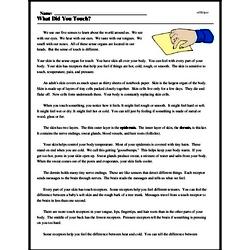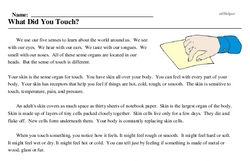What Did You Touch?
We use our five senses to learn about the world around us. We see with our eyes. We hear with our ears. We taste with our tongues. We smell with our noses. All of these sense organs are located in our heads. But the sense of touch is different.
Your skin is the sense organ for touch. You have skin all over your body. You can feel with every part of your body. Your skin has receptors that help you feel if things are hot, cold, rough, or smooth. The skin is sensitive to touch, temperature, pain, and pressure.
An adult's skin covers as much space as thirty sheets of notebook paper. Skin is the largest organ of the body. Skin is made up of layers of tiny cells packed closely together. Skin cells live only for a few days. They die and flake off. New cells form underneath them. Your body is constantly replacing skin cells.
When you touch something, you notice how it feels. It might feel rough or smooth. It might feel hard or soft. It might feel wet or dry. It might feel hot or cold. You can tell just by feeling if something is made of metal or wood, glass or fur.
The skin has two layers. The thin outer layer is the epidermis. The inner layer of skin, the dermis, is thicker. It contains the nerve endings, sweat glands, blood vessels, and hair roots (follicles).




